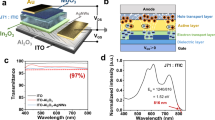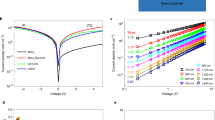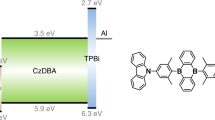Abstract
Organic light-emitting transistors, three-terminal devices combining a thin-film transistor with a light-emitting diode, have generated increasing interest in organic electronics. However, increasing their efficiency while keeping the operating voltage low still remains a key challenge. Here, we demonstrate organic permeable base light-emitting transistors; these three-terminal vertical optoelectronic devices operate at driving voltages below 5.0 V; emit in the red, green and blue ranges; and reach, respectively, peak external quantum efficiencies of 19.6%, 24.6% and 11.8%, current efficiencies of 20.6 cd A–1, 90.1 cd A–1 and 27.1 cd A–1 and maximum luminance values of 9,833 cd m–2, 12,513 cd m–2 and 4,753 cd m–2. Our simulations demonstrate that the nano-pore permeable base electrode located at the centre of the device, which forms a distinctive optical microcavity and regulates charge carrier injection and transport, is the key to the good performance obtained. Our work paves the way towards efficient and low-voltage organic light-emitting transistors, useful for power-efficient active matrix displays and solid-state lighting.
This is a preview of subscription content, access via your institution
Access options
Access Nature and 54 other Nature Portfolio journals
Get Nature+, our best-value online-access subscription
$29.99 / 30 days
cancel any time
Subscribe to this journal
Receive 12 print issues and online access
$259.00 per year
only $21.58 per issue
Buy this article
- Purchase on Springer Link
- Instant access to full article PDF
Prices may be subject to local taxes which are calculated during checkout





Similar content being viewed by others
Data availability
All the data that support this study are included in this article and its Supplementary Information files. The data that support the findings of this study are also available from the corresponding author upon reasonable request. Source data are provided with this paper.
References
Burroughes, J. H. et al. Light-emitting diodes based on conjugated polymers. Nature 347, 539–541 (1990).
Baldo, M. A. et al. Highly efficient phosphorescent emission from organic electroluminescent devices. Nature 395, 151–154 (1998).
Reineke, S. et al. White organic light-emitting diodes with fluorescent tube efficiency. Nature 459, 234–238 (2009).
Yonebayashi, Y. et al. High refresh rate and low power consumption AMOLED panel using top-gate n-oxide and p-LTPS TFTs. J. Soc. Inf. Disp. 28, 350–359 (2020).
Zaumseil, J. & Sirringhaus, H. Electron and ambipolar transport in organic field-effect transistors. Chem. Rev. 107, 1296–1323 (2007).
Muccini, M. A bright future for organic field-effect transistors. Nat. Mater. 5, 605–613 (2006).
Cicoira, F. & Santato, C. Organic light emitting field effect transistors: advances and perspectives. Adv. Funct. Mater. 17, 3421–3434 (2007).
Zhang, C., Chen, P. & Hu, W. Organic light-emitting transistors: materials, device configurations, and operations. Small 12, 1252–1294 (2016).
Liu, C.-F., Liu, X., Lai, W.-Y. & Huang, W. Organic light-emitting field-effect transistors: device geometries and fabrication techniques. Adv. Mater. 30, 1802466 (2018).
Hepp, A. et al. Light-emitting field-effect transistor based on tetracene thin film. Phys. Rev. Lett. 91, 157406 (2003).
Santato, C., Cicoira, F. & Martel, R. Spotlight on organic transistors. Nat. Photon. 5, 392–393 (2011).
Zaumseil, J., Friend, R. H. & Sirringhaus, H. Spatial control of the recombination zone in an ambipolar light-emitting organic transistor. Nat. Mater. 5, 69–74 (2005).
Zaumseil, J., Donley, C. L., Kim, J.-S., Friend, R. H. & Sirringhaus, H. Efficient top-gate, ambipolar, light-emitting field-effect transistors based on a green-light-emitting polyfluorene. Adv. Mater. 18, 2708–2712 (2006).
Hsu, B. B. Y. et al. Control of efficiency, brightness, and recombination zone in light-emitting field effect transistors. Adv. Mater. 24, 1171–1175 (2012).
Swensen, J. S., Soci, C. & Heeger, A. J. Light emission from an ambipolar semiconducting polymer field-effect transistor. Appl. Phys. Lett. 87, 253511 (2005).
Bisri, S. Z. et al. High mobility and luminescent efficiency in organic single-crystal light-emitting transistors. Adv. Funct. Mater. 19, 1728–1735 (2009).
Capelli, R. et al. Interface functionalities in multilayer stack organic light emitting transistors (OLETs). Adv. Funct. Mater. 24, 5603–5613 (2014).
Zaumseil, J., Donley, C. L., Kim, J. S., Friend, R. H. & Sirringhaus, H. Efficient top-gate, ambipolar, light-emitting field-effect transistors based on a green-light-emitting polyfuorene. Adv. Mater. 18, 2708–2712 (2006).
Takenobu, T. et al. High current density in light-emitting transistors of organic single crystals. Phys. Rev. Lett. 100, 066601 (2008).
Hou, L. et al. Optically switchable organic light-emitting transistors. Nat. Nanotechnol. 14, 347–353 (2019).
Zaumseil, J. et al. Quantum efficiency of ambipolar light-emitting polymer field-effect transistors. J. Appl. Phys. 103, 064517 (2008).
Namdas, E. B., Ledochowitsch, P., Yuen, J. D., Moses, D. & Heeger, A. J. High performance light emitting transistors. Appl. Phys. Lett. 92, 183304 (2008).
Capelli, R. et al. Organic light-emitting transistors with an efficiency that outperforms the equivalent light-emitting diodes. Nat. Mater. 9, 496–503 (2010).
Maiorano, V., Bramanti, A., Carallo, S., Cingolani, R. & Gigli, G. Organic light emitting field effect transistors based on an ambipolar p-i-n layered structure. Appl. Phys. Lett. 96, 133305 (2010).
Namdas, E. B. et al. Organic light emitting complementary inverters. Appl. Phys. Lett. 96, 043304 (2010).
Gwinner, M. C. et al. Highly efficient single-layer polymer ambipolar light-emitting field-effect transistors. Adv. Mater. 24, 2728–2734 (2012).
Chaudhry, M. et al. Organic light-emitting transistors: advances and perspectives. Adv. Funct. Mater. 30, 1905282 (2019).
Chaudhry, M. et al. Low-voltage solution-processed hybrid light-emitting transistors. ACS Appl. Mater. Interfaces 10, 18445–18449 (2018).
Ahmad, V. et al. High EQE and high brightness solution-processed TADF light-emitting transistors and OLEDs. Adv. Optical Mater. 8, 2000554 (2020).
Yamauchi, H., Iizuka, M. & Kudo, K. Fabrication of vertical organic light-emitting transistor using ZnO thin film. Jpn J. Appl. Phys. 46, 2678–2682 (2007).
Xu, Z., Li, S. H., Ma, L., Li, G. & Yang, Y. Vertical organic light emitting transistor. Appl. Phys. Lett. 91, 092911 (2007).
Nakamura, K. et al. Improvement of metal–insulator–semiconductor-type organic light-emitting transistors. Jpn J. Appl. Phys. 47, 1889–1893 (2008).
McCarthy, M. A. et al. Low-voltage, low-power, organic light-emitting transistors for active matrix displays. Science 332, 570–573 (2011).
Yu, H., Dong, Z., Guo, J., Kim, D. & So, F. Vertical organic field-effect transistors for integrated optoelectronic applications. ACS Appl. Mater. Interfaces 8, 10430–10435 (2016).
Yu, H., Ho, S., Barange, N., Larrabee, R. & So, F. Semi-transparent vertical organic light-emitting transistors. Org. Electron. 55, 126–132 (2018).
Lee, G. et al. Vertical organic light-emitting transistor showing a high current on/off ratio through dielectric encapsulation for the effective charge pathway. J. Appl. Phys. 121, 024502 (2017).
Klinger, P. et al. Organic power electronics: transistor operation in the kA/cm2 regime. Sci. Rep. 7, 44713 (2017).
Kheradmand-Boroujeni, B. et al. A pulse-biasing small-signal measurement technique enabling 40 MHz operation of vertical organic transistors. Sci. Rep. 8, 7643 (2018).
Dollinger, F. et al. Electrically stable organic permeable base transistors for display applications. Adv. Electron. Mater. 5, 1900576 (2019).
Schubert, S., Meiss, J., Müller-Meskamp, L. & Leo, K. Improvement of transparent metal top electrodes for organic solar cells by introducing a high surface energy seed layer. Adv. Energy Mater. 3, 438–444 (2013).
Lenk, S. et al. White organic light-emitting diodes with 4 nm metal electrode. Appl. Phys. Lett. 107, 163302 (2015).
Dollinger, F. et al. Vertical organic thin-film transistors with an anodized permeable base for very low leakage current. Adv. Mater. 31, 1900917 (2019).
Kim, K.-H., Moon, C.-K., Lee, J.-H., Kim, S.-Y. & Kim, J.-J. Highly efficient organic light-emitting diodes with phosphorescent emitters having high quantum yield and horizontal orientation of transition dipole moments. Adv. Mater. 26, 3844–3847 (2014).
Uoyama, H., Goushi, K., Shizu, K., Nomura, H. & Adachi, C. Highly efficient organic light-emitting diodes from delayed fluorescence. Nature 492, 234–238 (2012).
Baldo, M. A., Adachi, C. & Forrest, S. R. Transient analysis of organic electrophosphorescence. II. Transient analysis of triplet-triplet annihilation. Phys. Rev. B 62, 10967–10977 (2000).
Matsushima, T. et al. High performance from extraordinarily thick organic light-emitting diodes. Nature 572, 502–506 (2019).
Ràfols-Ribé, J. et al. High-performance organic light-emitting diodes comprising ultrastable glass layers. Sci. Adv. 4, eaar8332 (2018).
Sentaurus Device User Manual in TCAD v. 2019.12 (Synopsys, 2019).
Darbandy, G. et al. Unraveling structure and device operation of organic permeable base transistors. Adv. Electron. Mater. 6, 2000230 (2020).
Guo, E. et al. Vertical organic permeable dual-base transistors for logic circuits. Nat. Commun. 11, 4725 (2020).
Will, P.-A. et al. Scattering quantified: evaluation of corrugation induced outcoupling concepts in organic light-emitting diodes. Org. Electron. 58, 250–256 (2018).
Huang, Y.-H. et al. Unlocking the full potential of conducting polymers for high-efficiency organic light-emitting devices. Adv. Mater. 27, 929–934 (2015).
Meerheim, R., Furno, M., Hofmann, S., Lüssem, B. & Leo, K. Quantification of energy loss mechanisms in organic light-emitting diodes. Appl. Phys. Lett. 97, 253305 (2010).
Scholz, S., Kondakov, D., Lüssem, B. & Leo, K. Degradation mechanisms and reactions in organic light-emitting devices. Chem. Rev. 115, 8449–8503 (2015).
Acknowledgements
We gratefully acknowledge the funding by Deutsche Forschungsgemeinschaft (DFG) in the fflexcom SPP. Z.W. appreciates the funding from the Fundamental Research Funds for the Central Universities and the Alexander von Humboldt Foundation. Y.L. and E.G. acknowledge financial support from the China Scholarship Council (no. 201506920047 and 201706890003). We acknowledge the use of the HZDR Ion Beam Center transmission electron microscopy facilities and the funding of transmission electron microscope Talos by the German Federal Ministry of Education of Research (BMBF; grant no. 03SF0451) in the frame-work of HEMCP. We thank S. Lenk and S. Reineke at Technische Universität Dresden for fruitful discussions, A. Tahn at Dresden Center for Nanoanalysis (DCN) for assistance with the scanning electron microscopy measurement and P. Formánek at Leibniz-Institut für Polymerforschung Dresden e.V. (IPF) for the transmission electron microscopy measurement. Z.W. also appreciates the support from the Institute of Flexible Electronics and Northwestern Polytechnical University.
Author information
Authors and Affiliations
Contributions
Z.W., H.K. and K.L. supervised this project. Z.W., Y.L., H.K. and K.L. conceived the idea and designed the experiments. Z.W. and Y.L. carried out the calibration of the measurement equipment, device characterizations and the optical simulations. Y.L. conducted the optical measurement. E.G. was involved in the sample preparation and device characterizations (electrical characterization, scanning electron microscopy and atomic force microscopy) and contributed to the interpretation of the data. G.D. and A.K. made the TCAD simulation. R.H. performed the HAADF-STEM and energy-dispersive X-ray spectroscopy measurements. Z.W., Y.L., E.G., S.-J.W., H.K. and K.L. analysed the data and cowrote the manuscript. All authors commented on the manuscript.
Corresponding author
Ethics declarations
Competing interests
The authors declare no competing interests.
Additional information
Peer review information Nature Materials thanks Michele Muccini, Andrew Rinzler and the other, anonymous, reviewer(s) for their contribution to the peer review of this work.
Publisher’s note Springer Nature remains neutral with regard to jurisdictional claims in published maps and institutional affiliations.
Supplementary information
Supplementary Information
Supplementary Figs. 1–16, Notes 1 and 2, Tables 1–4 and references.
Supplementary Video 1
The on/off switching function of OPB-LETs.
Supplementary Video 2
The luminance variation of OPB-LETs.
Source data
Source Data Fig. 3
EQE, luminance and current efficiency of red, green and blue OPB-LETs.
Source Data Fig. 5
Optical simulation of the green OPB-LETs.
Rights and permissions
About this article
Cite this article
Wu, Z., Liu, Y., Guo, E. et al. Efficient and low-voltage vertical organic permeable base light-emitting transistors. Nat. Mater. 20, 1007–1014 (2021). https://doi.org/10.1038/s41563-021-00937-0
Received:
Accepted:
Published:
Issue Date:
DOI: https://doi.org/10.1038/s41563-021-00937-0
This article is cited by
-
Bioelectronics goes vertical
Nature Materials (2023)
-
Analytical modeling of organic permeable-base transistors based on geometrical parametrization
Journal of the Korean Physical Society (2023)
-
Organic permeable base light-emitting transistor: a new concept device architecture for display technology
Science China Chemistry (2021)



